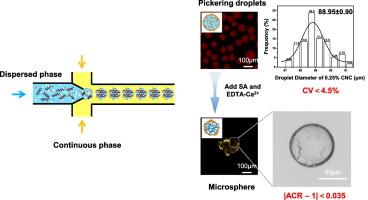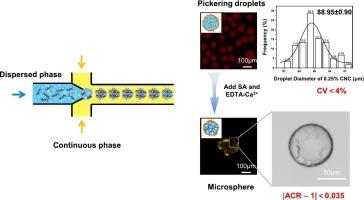使用微流体技术精确形成食品应用皮克林液滴和微球
IF 9.8
1区 农林科学
Q1 CHEMISTRY, APPLIED
引用次数: 0
摘要
液滴和微球在食品领域有着广泛的应用。然而,传统方法制备的液滴和微球单分散性差,尺寸分布宽,形貌不均匀。在本研究中,我们通过微流体制备皮克林液滴和微球来提高可控性。液滴粒径分布窄,变异系数(CV)小于4.5 %。cnc稳定液滴的平均直径为92.23 ± 4.62 μm。此外,海藻酸钠(SA)与Ca2+交联形成微球。微球在保持弹性支撑性能的同时具有中等的抗变形硬度。它们的面积周长比(ACR)与1的绝对差值(即|ACR - 1|)小于0.035,显示出较高的均匀性。总的来说,我们提供了一种微流体方法来制备液滴和微球,大大增强了其均匀性和可控性。我们的工作中使用的成分是安全无毒的,可以为创新的食品结构设计提供见解。本文章由计算机程序翻译,如有差异,请以英文原文为准。


Precise formation of food applied Pickering droplets and microspheres using microfluidic technology
Droplets and microspheres have broad applications in food fields. However, the droplets and microspheres prepared by traditional methods exhibit poor monodispersity, wide size distribution, and inhomogeneous morphology. In this study, we prepared Pickering droplets and microspheres via microfluidics to improve the controllability. The droplets showed a narrow size distribution, with coefficients of variation (CV) below 4.5 %. CNC-stabilized droplets achieved an average diameter of 92.23 ± 4.62 μm. Furthermore, sodium alginate (SA) was introduced to crosslink with Ca2+ to form microspheres. The microspheres exhibited moderate deformation-resistant hardness while maintaining elastic supportive properties. Their absolute difference between the area-to-circumference ratio (ACR) and 1 (i.e., |ACR - 1|) was less than 0.035, demonstrating the high uniformity. Overall, we provided a microfluidics method to prepare droplets and microspheres, which greatly enhanced its homogeneity and controllability. The ingredients used in our work were safe and nontoxic, which could provide insights for innovative food structure design.
求助全文
通过发布文献求助,成功后即可免费获取论文全文。
去求助
来源期刊

Food Chemistry
工程技术-食品科技
CiteScore
16.30
自引率
10.20%
发文量
3130
审稿时长
122 days
期刊介绍:
Food Chemistry publishes original research papers dealing with the advancement of the chemistry and biochemistry of foods or the analytical methods/ approach used. All papers should focus on the novelty of the research carried out.
 求助内容:
求助内容: 应助结果提醒方式:
应助结果提醒方式:


